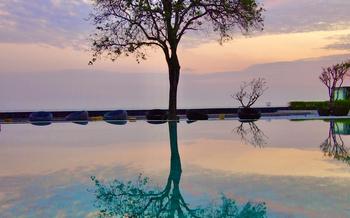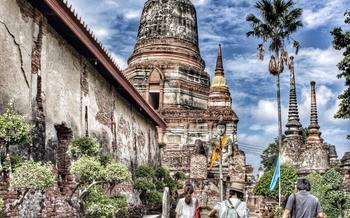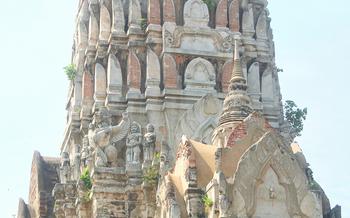
Wat Long Suan
- Wat Long Suan: A Majestic Temple in Ranong
- Location and Accessibility:
- Temple Grounds and Surroundings:
- Main Prayer Hall (Ubosot):
- Other Notable Structures:
- Religious Ceremonies and Festivals
- Monks' Quarters and Daily Life:
- Temple Etiquette and Dress Code:
- Volunteer Opportunities
- Local Cuisine and Restaurants
- Souvenirs and Handicrafts
- Nearby Attractions
- Accommodation Options
- Insider Tip: Unveiling the Temple's Hidden Gem
Wat Long Suan: A Majestic Temple in Ranong
In the heart of Ranong, Thailand, stands a magnificent temple that has captured the hearts of locals and visitors alike - Wat Long Suan. Steeped in history and religious significance, this sacred sanctuary invites you on a journey of spiritual exploration and cultural immersion.
Wat Long Suan, meaning "Temple of the Long Orchard," was founded in the late 19th century by a revered monk named Luang Pu Thuat. The temple's construction spanned several years, with each building meticulously crafted to reflect traditional Thai architecture and Buddhist symbolism.
Over the decades, Wat Long Suan has become a symbol of devotion, wisdom, and community. Locals flock to the temple for religious ceremonies, festivals, and to seek blessings from the resident monks. The temple's tranquil atmosphere and stunning architecture make it a popular destination for tourists seeking a glimpse into Thailand's rich cultural heritage.
As you step through the temple gates, you'll be greeted by a serene and awe-inspiring sight. Majestic stupas, intricate carvings, and golden spires adorn the temple grounds, creating a sense of reverence and tranquility.
The main prayer hall, known as the Ubosot, is the centerpiece of the temple complex. Its intricate murals depict scenes from the life of Buddha and Buddhist mythology, inviting visitors to contemplate the teachings and principles of Buddhism.
Inside the Sim, or Ordination Hall, you'll witness the sacred ceremonies where young men are ordained as Buddhist monks. The Sim is adorned with beautiful paintings and sculptures that depict the Buddha's journey to enlightenment.
My personal visit to Wat Long Suan was a transformative experience. As I wandered through the temple grounds, I felt a sense of peace and serenity wash over me. The intricate details of the architecture, the gentle chanting of the monks, and the warm smiles of the locals created a truly special and unforgettable moment.
Location and Accessibility:
Wat Long Suan is situated in the Mueang Ranong district of Ranong province, Thailand. To reach the temple, visitors can take a tuk-tuk or songthaew from the city center. The journey takes approximately 15 minutes. Alternatively, visitors can rent a motorbike or bicycle to explore the surrounding area at their own pace.
Once you arrive at Wat Long Suan, you'll find ample parking space for cars and tour buses. The temple is easily accessible for visitors of all abilities, with well-maintained paths and ramps leading to the main prayer hall, ordination hall, and other structures.
Temple Grounds and Surroundings:
The temple grounds of Wat Long Suan are meticulously maintained, showcasing the dedication and care of the monks and the community. Visitors are greeted by lush gardens filled with vibrant flowers, towering trees, and manicured lawns. The serene atmosphere invites contemplation and introspection, making it an ideal place to escape the hustle and bustle of daily life.
As you stroll through the grounds, you'll encounter intricate statues depicting mythical creatures, revered deities, and scenes from Buddhist mythology. These statues add a touch of magic and spirituality to the surroundings. Several stupas, or Buddhist reliquaries, can also be found scattered around the temple grounds. These majestic structures represent the wisdom and teachings of the Buddha and serve as a reminder of the temple's religious significance.
The cleanliness and maintenance of Wat Long Suan are exemplary. The grounds are swept daily, and the gardens are meticulously pruned, reflecting the deep respect and devotion of the local community towards their sacred temple. The overall ambiance of the temple is one of tranquility, serenity, and spiritual upliftment, making it a truly special place to visit.
Main Prayer Hall (Ubosot):
The main prayer hall, also known as the Ubosot, is the centerpiece of Wat Long Suan. It stands as a testament to the temple's architectural prowess, with its towering spires and intricate carvings adorning the exterior. The Ubosot's design follows traditional Thai Buddhist architecture, featuring a rectangular shape and a multi-tiered roof. The interior is equally impressive, exuding a sense of serenity and devotion. The walls are adorned with vibrant murals depicting scenes from the life of Buddha and other Buddhist teachings. The main altar, located at the far end of the hall, houses a revered Buddha image that draws pilgrims and devotees from near and far. The Ubosot is not only a place of worship but also serves as a venue for various religious ceremonies and rituals, including ordinations, chanting sessions, and meditation retreats.
Other Notable Structures:
Apart from the main prayer hall and ordination hall, Wat Long Suan features several other notable structures that contribute to its architectural and religious significance. These include:
-
Sala: A sala is a multi-purpose pavilion commonly found in Thai temples. At Wat Long Suan, there are several salas located throughout the grounds, offering visitors a place to rest, meditate, or simply enjoy the serene atmosphere.
-
Chedi: A chedi, also known as a stupa, is a tall, spire-like monument that symbolizes the Buddha's relics. Wat Long Suan is home to several chedis of varying sizes and designs, each with its own unique symbolism and significance.
-
Wihan: A wihan is a large hall or building used for religious ceremonies, meetings, or other gatherings. At Wat Long Suan, the wihan is located near the main prayer hall and serves as a multi-purpose space for various temple activities.
Each of these structures contributes to the overall beauty and functionality of Wat Long Suan, offering visitors a glimpse into the rich architectural traditions of Thai Buddhism.
Religious Ceremonies and Festivals
Wat Long Suan is an active temple that hosts several religious ceremonies and festivals throughout the year. These events hold great significance for the local community and offer visitors a chance to immerse themselves in the rich cultural traditions of Ranong.
One of the most important festivals celebrated at Wat Long Suan is Songkran, the Thai New Year. During this festival, which takes place in April, the temple grounds are decorated with colorful banners and flowers, and water is splashed as a symbol of purification and good luck. Visitors can participate in the water-throwing festivities and enjoy the lively atmosphere of the temple during this special time.
Another significant event is Visakha Puja, which commemorates the birth, enlightenment, and passing of Lord Buddha. This festival is observed in May and is marked by special prayers, chanting, and meditation sessions at the temple. Visitors can join the monks and local devotees in celebrating the life and teachings of Buddha during this sacred occasion.
In addition to these major festivals, Wat Long Suan also hosts regular ceremonies and rituals throughout the year. These include daily morning and evening prayers, as well as special ceremonies for ordinations, weddings, and other important life events. Visitors are welcome to observe these ceremonies and gain insights into the religious practices and beliefs of the local community.
Monks' Quarters and Daily Life:
Beyond the temple's grand structures, the monks' quarters provide a glimpse into the daily life of those who have dedicated their lives to spiritual pursuits. Tucked away in a serene corner of the temple grounds, the monks' living quarters exude an aura of tranquility and simplicity. Visitors are welcome to observe the monks' daily routines, which typically begin early in the morning with meditation and chanting. Throughout the day, they engage in various activities such as studying Buddhist scriptures, practicing mindfulness, and performing temple duties. The monks' simple lifestyle, devoid of material possessions, serves as a reminder of the core teachings of Buddhism. Visitors who seek spiritual guidance or wish to learn more about monastic life can interact with the monks during designated times and receive their blessings. The monks' wisdom and compassion often leave a lasting impression on visitors, offering a deeper understanding of the Buddhist way of life.
Temple Etiquette and Dress Code:
When visiting Wat Long Suan, it is essential to be mindful of temple etiquette and dress code to show respect for local customs and traditions. Visitors should dress modestly, avoiding revealing or overly casual clothing. Shoulders and knees should be covered, and footwear must be removed before entering the temple grounds. It is customary to walk barefoot or in socks while inside the temple.
Visitors should also be mindful of their behavior and maintain a respectful demeanor. Loud talking, shouting, or running is not appropriate within the temple grounds. It is essential to be mindful of your surroundings and avoid disturbing monks or other visitors engaged in prayer or meditation.
When interacting with monks, it is important to show respect and humility. Monks should be addressed as "Phra" or "Luang Phor," and visitors should refrain from touching or making physical contact with them. It is also considered polite to wai, a traditional Thai greeting involving raising your hands together in a prayer-like gesture, when approaching or leaving a monk.
By following these guidelines, visitors can show respect for the local culture and ensure a harmonious and enjoyable experience at Wat Long Suan.
Volunteer Opportunities
Wat Long Suan offers a unique opportunity for visitors to engage in volunteer work and contribute to the temple's upkeep and maintenance. Volunteering at the temple is a rewarding experience that allows visitors to immerse themselves in the local culture and give back to the community.
There are various volunteer activities available at the temple, catering to different interests and skills. Visitors can assist with teaching English to the young monks, helping with gardening and landscaping, or participating in temple maintenance and cleaning activities.
Volunteering at Wat Long Suan is a meaningful way to connect with the local community and learn about Buddhist practices and traditions. It is also an excellent opportunity to practice mindfulness, compassion, and generosity.
To get involved in volunteer work at Wat Long Suan, visitors can contact the temple directly or inquire at the temple office during their visit. The temple welcomes volunteers from all backgrounds and experience levels, and they are always grateful for the support and assistance they receive.
Local Cuisine and Restaurants
After exploring the sacred grounds of Wat Long Suan, visitors can indulge in the delectable flavors of Ranong's local cuisine. The area surrounding the temple offers a diverse range of restaurants, from humble food stalls to elegant eateries, catering to every taste and budget.
For a truly authentic experience, try the regional specialty, Ranong-style crab curry. This mouthwatering dish features fresh crab cooked in a rich and aromatic curry sauce, accompanied by a variety of vegetables and spices. Served with steamed rice, it's a symphony of flavors that will tantalize your taste buds.
If you prefer seafood, don't miss the grilled squid with spicy dipping sauce. Succulent squid, expertly grilled over charcoal, is paired with a tangy and flavorful dipping sauce, creating a perfect balance of flavors. This dish is a favorite among locals and tourists alike.
For vegetarians, there are plenty of options to choose from. The tofu stir-fried with vegetables is a healthy and delicious dish that showcases the region's fresh produce. The tofu is cooked to perfection, absorbing the flavors of the vegetables and sauce, resulting in a satisfying and nutritious meal.
When in Ranong, be sure to sample the local fruits, which are renowned for their sweetness and juiciness. From the fragrant mangosteens to the refreshing papayas, there's a tropical treat for everyone.
To accompany your meal, try the refreshing local coconut water. Harvested from the abundant coconut trees in the region, this natural beverage is a thirst-quencher that's both healthy and delicious.
Whether you're looking for a quick bite or a leisurely dining experience, the area around Wat Long Suan has something to offer every palate. Embrace the opportunity to savor the local cuisine and immerse yourself in the culinary delights of Ranong.
Souvenirs and Handicrafts
At Wat Long Suan, visitors can find a small shop selling souvenirs, handicrafts, and religious items that represent the temple and the local culture. These items are often handmade by local artisans and craftsmen, providing a unique opportunity to support the community while taking home a meaningful memento of your visit.
From intricate wooden carvings and colorful textiles to traditional Thai amulets and Buddhist statues, there is something for everyone at the temple shop. Visitors can find unique souvenirs like handmade Buddha images, intricate carvings depicting scenes from Thai mythology, and beautiful jewelry adorned with precious stones. These items are not only aesthetically pleasing but also hold cultural and religious significance.
Purchasing souvenirs from the temple shop not only supports local artisans but also contributes to the upkeep and maintenance of the temple grounds. By choosing to buy from the temple shop, visitors can directly support the preservation of this sacred space and ensure that it continues to thrive for generations to come.
Nearby Attractions
In the vicinity of Wat Long Suan, visitors can find several other captivating attractions that offer a glimpse into the rich history and culture of the region. Nature enthusiasts can venture into the Khao Phanom Bencha National Park, renowned for its breathtaking waterfalls, lush rainforests, and diverse wildlife. History buffs will delight in exploring the Ranong Provincial Museum, which houses a collection of artifacts and exhibits showcasing the province's fascinating past. For a unique cultural experience, the Ranong Night Market offers a lively atmosphere with a variety of street food stalls, souvenirs, and handicrafts. These nearby attractions complement the allure of Wat Long Suan, providing visitors with a well-rounded and unforgettable travel experience.
Accommodation Options
When planning your visit to Wat Long Suan, consider staying in the nearby town of Ranong to fully immerse yourself in the local culture. For budget-conscious travelers, the Ranong Backpackers Hostel offers affordable dormitory-style accommodations with a friendly atmosphere. Alternatively, the Thepa Hotel Ranong provides a comfortable and convenient option within walking distance of the temple. For families or those seeking a more luxurious experience, the Ranong Grand Hotel features spacious rooms, a swimming pool, and stunning views of the surrounding mountains.
Insider Tip: Unveiling the Temple's Hidden Gem
Beyond the main attractions of Wat Long Suan, there lies a hidden gem that often goes unnoticed by visitors. Tucked away in a secluded corner of the temple grounds is a small meditation cave, accessible through a narrow and winding path. Here, visitors can find a tranquil sanctuary for reflection and spiritual contemplation. The cave is adorned with intricate carvings and paintings depicting scenes from Buddhist mythology, creating an atmosphere of serenity and devotion. Whether you're seeking a moment of peace or a deeper connection with your spiritual side, this hidden gem is a must-visit for those who appreciate the tranquility and beauty of Wat Long Suan.



